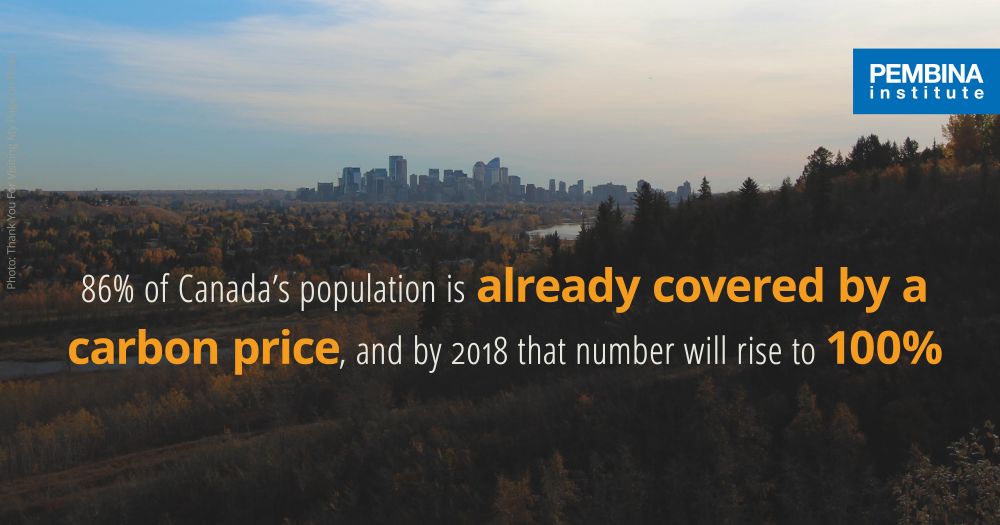Against the backdrop of a Trump administration insisting that the United States’ economy is heading back to the coal age, Canada’s clean growth strategy is a breath of fresh air. Now more than ever, Canada needs to continue to innovate on decarbonizing its economy, and a central plank of that strategy is putting a price on carbon pollution.
With 86 percent of Canada’s population now covered by a carbon pollution price, and 100 percent to be covered by 2018 under the national benchmark, the country is well positioned to be an international beacon of progress and a major competitor in the clean global economy.
Here are four big reasons why Canada should strengthen its resolve to move forward on carbon pollution pricing.
1. Canada is not alone
Given the effectiveness of carbon pricing as a key component of any emissions-reduction strategy, it should come as no surprise that 25 percent of global carbon pollution is already or about to be covered by a carbon price. That represents over 40 countries, including seven of the world’s 10 largest economies.
China has already piloted cap-and-trade in five provinces and two cities, making it the second-largest carbon market in the world, after the European Union. Later this year, China’s carbon market is expected to go national, making it the world’s largest. Carbon pollution pricing is now a mainstream approach, and Canada is positioned to demonstrate how to do it well.
2. Carbon pollution pricing will help Canada become a clean tech powerhouse
The global clean tech market is currently worth $1.15 trillion (CAD) and expected to grow to $2.5 trillion in 2022, according to Analytica Advisors. While Canada’s exports are growing in this sector, its overall share of this vital pie is shrinking (from 2.2 percent to 1.3 percent of the market over the last 10 years) as other countries outpace Canada in clean tech development.
Today, five of the six largest manufacturers of solar panels are based in China. That’s a figure that we would have expected to hear about Germany in the past — proof the market is changing quickly.
Carbon pricing is one of the tools clean tech entrepreneurs cite as key to supporting innovation. By moving forward on carbon pricing and other clean growth policies, Canada can catch up and be positioned to take advantage of growing and shifting global market opportunities. Currently, 23 percent of Canadian clean tech exports are destined for non-U.S. markets, but this share is anticipated to increase to a third in the next four years.
3. Carbon leakage and competitiveness concerns can be addressed by smart design
Identifying and mitigating competitive disadvantages must be a priority for Canada to ensure that pricing carbon pollution doesn’t result in carbon leakage and doesn’t adversely impact the economy.
Canada’s Ecofiscal Commission estimates that around 5 percent of Canada’s economy (with variation between 2 percent and 18 percent depending on the province or territory) could be subject to competitiveness impacts if the country has a higher carbon pollution price than jurisdictions with whom it trades.
Craig Alexander, chief economist at the Conference Board of Canada, recently argued that competitiveness impacts would be less than 0.15 percent of GDP and not a justification to delay.
Where impacts are felt, carbon leakage issues can be addressed by the design of the pricing framework. Any measures taken to address competitiveness concerns for emissions-intensive, trade-exposed sectors should maintain the incentive to reduce pollution, as well as be targeted, transparent, consistent, temporary and simple.
4. Carbon pollution pricing lets the market drive the solutions
Along with some 140 other countries, Canada committed 18 months ago in Paris to do its part to reduce carbon pollution sufficiently to stay well below 2°C of warming. In order to achieve that goal, government has two main levers with which to shift to a lower-carbon economy: pricing and regulation.
As a market-based mechanism — with support from both ends of the political spectrum — carbon pollution pricing sets the rules of engagement and lets the market pick the most efficient and effective ways to grow the economy. It supports innovation and ensures that those technologies and solutions that deliver the best results are the ones that thrive and go on to be competitive exports to a rapidly decarbonizing global economy.
With the U.S. waffling on its commitment to the Paris Agreement, it’s more important than ever for Canada to step up to be a global leader and demonstrate that addressing climate change is how we will build a strong economy that can weather the storms to come.
Josha MacNab is the British Columbia director at the Pembina Institute, Canada’s leading clean energy think-tank.
Charles Komanoff, an economist, is the cofounder and director of the New York-based Carbon Tax Center.
This article originally appeared in The Hill (Washington, D.C.) on May 9, 2017.








